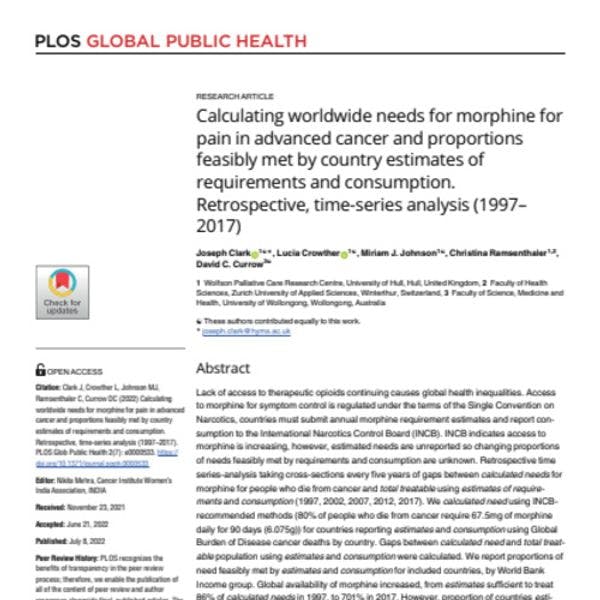Calculando las necesidades de morfina a nivel mundial para aliviar el dolor en casos de cáncer avanzado y proporciones factiblemente satisfechas, mediante estimados de requerimientos y consumo por país
Clark et al. analizan la brecha entre los requerimientos y necesidades estimados de morfina, y su consumo real, concluyendo que menos de una tercera parte de los países del mundo satisfacen las necesidades de los pacientes. Más información, en inglés, está disponible abajo.
By Joseph Clark, Lucia Crowther, Miriam J. Johnson , Christina Ramsenthaler, and David C. Currow / PLOS Global Public Health
Abstract
Lack of access to therapeutic opioids continuing causes global health inequalities. Access to morphine for symptom control is regulated under the terms of the Single Convention on Narcotics, countries must submit annual morphine requirement estimates and report consumption to the International Narcotics Control Board (INCB). INCB indicates access to morphine is increasing, however, estimated needs are unreported so changing proportions of needs feasibly met by requirements and consumption are unknown. Retrospective time series-analysis taking cross-sections every five years of gaps between calculated needs for morphine for people who die from cancer and total treatable using estimates of requirements and consumption (1997, 2002, 2007, 2012, 2017). We calculated need using INCB-recommended methods (80% of people who die from cancer require 67.5mg of morphine daily for 90 days (6.075g)) for countries reporting estimates and consumption using Global Burden of Disease cancer deaths by country. Gaps between calculated need and total treatable population using estimates and consumption were calculated. We report proportions of need feasibly met by estimates and consumption for included countries, by World Bank Income group. Global availability of morphine increased, from estimates sufficient to treat 86% of calculated needs in 1997, to 701% in 2017. However, proportion of countries estimating requirements feasibly meeting >100% of calculated needs rose only from 16% to 30%. Almost all Low-and-Middle-Income Countries submitted inadequate estimates with little change in 20 years. Consumption was lower than calculated needs at all time-points. Very few countries reported consumption greater than their estimate of requirement. Most countries submitted morphine estimates insufficient to meet analgesic needs of people who died from cancer. Estimates of requirements contextualise future Consumption, and increases in adequacy of estimates and consumption were minimal over 20 years. Annual publication of calculated morphine needs alongside estimates and consumption may be a key step to drive countries’ accountabilities.
